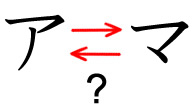 |
Katakana ア and マ may become indistinguishable
- if the second stroke of ア is tilted like a backward slash

OR
- if the second stroke of マ is curved toward left ノ.
|
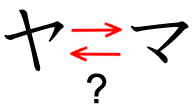 |
Katakana ヤ and マ may become indistinguishable
- if the second stroke of ヤ does not cross the first stroke
OR
- if the second stroke of マ crosses the first stroke.
|
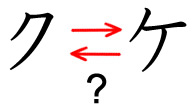 |
Katakana ク and ケ may become indistinguishable
- if the second stroke of ク starts at the middle of the first stroke (
 ) )
and/or the second stroke of
ク is separated into two strokes ( ). ).
OR
- if the last two strokes of ケ are written as one stroke (フ).
|
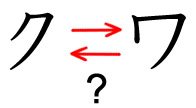 |
Katakana ク and ワ may become indistinguishable
- if the tilted first stroke of ク is written vertically like |
and/or if the horizontal part of the second stroke is too long
OR
- if the first stroke of ワ is tilted like a slash /
and/or if the horizontal part of the second stroke is too short.
|
 |
Katakana ナ and メ may become indistinguishable
- if the horizontal stroke of ナ is tilted (
 ) )
OR
- if the tilted stroke of メ is written horizontally (ー).
|
 |
Katakana コ and ユ may become indistinguishable
- if the last stroke of コ extends beyond the end of the first stroke
OR
- if the last stroke of ユ stops at the end of the first stroke.
|
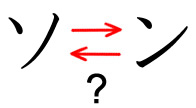 |
Katakana ソ may become katakana ン, or the other way around
- if the second stroke of ソ is written upward (
 ) )
OR
- if the second stroke of ン is written downward (
 ). ).
|
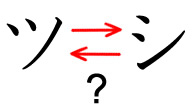 |
Katakana ツ may become katakana シ, or the other way around
- if the second stroke of ツ is written upward (
 ), ),
and/or if the first two short strokes are stacked vertically
( ) )
OR
- if the second stroke of シ is written downward (
 ), ),
and/or if the first two short strokes are stacked sideways ( ). ).
|
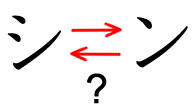 |
Katakana シ may become katakana ン, or the other way around
- if one of the first two short strokes of シ is missing.
OR
- if there is an extra short stroke in ン.
|
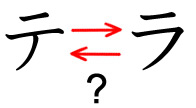 |
Katakana テ may become katakana ラ, or the other way around
- if the last two strokes of テ are written as one stroke (フ)
OR
- if the last stroke of ラ is written as two strokes (
 ). ).
|
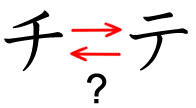 |
Katakana チ may look like katakana テ, or the other way around
- if the last stroke of チ does not cross the second stroke (
 ) )
OR
- if the last stroke of テ crosses the second stroke (ナ).
FYI: There is also a significant difference between チand テ.
The first stroke of チgoes right to left in an angle ( ) )
while the first stroke of テ goes left to right horizontally (→). |
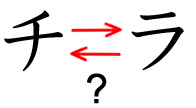 |
Katakana チ may look like katakana ラ, or the other way around
- if the last stroke of チ does not cross the second stroke (フ)
OR
- if the last stroke of ラ is written as two strokes crossing one
another (ナ).
FYI: There is also a significant difference between チand ラ.
The first stroke of チgoes right to left in an angle ( ) )
while the first stroke of テ goes left to right horizontally (→). |
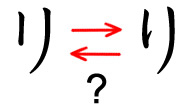 |
Katakana リ may look like hiragana り, or the other way around
- if the first stroke of katakana リ is written with a hook
and/or is connected with the second
(り)
OR
- if the first stroke of hiragana り is written in a straight vertical line
without a hook.
|
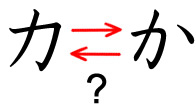 |
Katakana カ may look like hiragana か, or the other way around
- if there is an extra short stroke in katakana カ
OR
- if the last short stroke is missing in hiragana か.
|
 |
Katakana セ may look like hiragana せ, or the other way around
- if there is an extra short vertical stroke in katakana セ
OR
- if the short vertical stroke is missing in hiragana せ.
|
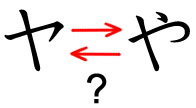 |
Katakana ヤ may look like hiragana や, or the other way around
- if there is an extra short stroke in katakana ヤ
OR
- if the short stroke is missing in hiragana や.
|
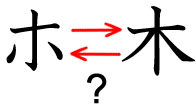 |
Katakana ホ may look like kanji 木 (to be introduced later),
or the other way around
- if the last two short strokes of ホ touch the cross part (十)
OR
- if the last two strokes of 木 are separated from the cross part (十).
|
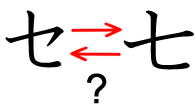 |
Katakana セ may look like kanji 七 (to be introduced later),
or the other way around
- if the first stroke of セ does not have a hook
OR
- if the fisrt stroke of 七 has a hook.
|